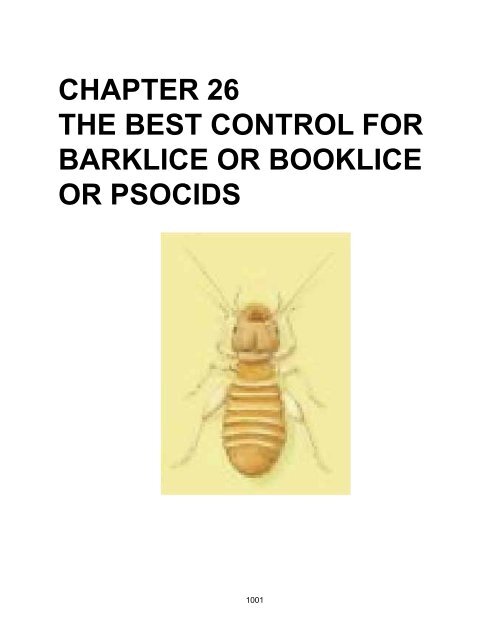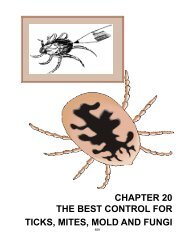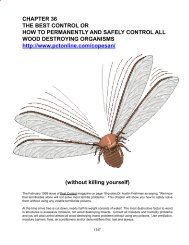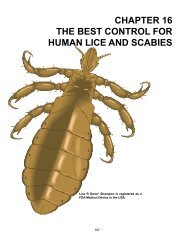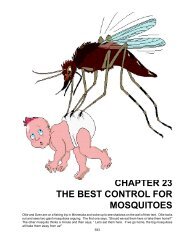The Best Control For Barklice Or - The Best Control 2
The Best Control For Barklice Or - The Best Control 2
The Best Control For Barklice Or - The Best Control 2
You also want an ePaper? Increase the reach of your titles
YUMPU automatically turns print PDFs into web optimized ePapers that Google loves.
CHAPTER 26<br />
THE BEST CONTROL FOR<br />
BARKLICE OR BOOKLICE<br />
OR PSOCIDS<br />
1001
BARKLICE OR BOOKLICE OR DUST LICE OR PSOCIDS<br />
Appearance. Most species are free-living and not pests, but several<br />
species of book lice are found indoors, e.g., the common booklouse-<br />
Liposcelis divinatorius (Mull). <strong>The</strong>y are of rather similar appearance<br />
and they all have a superficial resemblance to some other lice species-<br />
hence their names. <strong>The</strong>y are very small insects with soft bodies,<br />
cream to gray or light brown in color. Four wings (like cellophane) are<br />
usually absent from those found indoors although other outside species<br />
possess the two pairs. A pair of wing-pads may also be present. In<br />
many species, males are absent, parthogenetic reproduction being the<br />
rule. <strong>The</strong>ir antennae are long and thread-like, 11-50 segmented. <strong>The</strong><br />
head is relatively large as are the antennae, but the eyes are poorly<br />
developed. <strong>The</strong> femora on the hind legs are enlarged as though it were<br />
able to leap, but such is not the case. <strong>The</strong> insect, however, can and<br />
does run quickly and it is this habit which usually causes the occupants<br />
to be aware of its presence. One interesting habit shown by the species<br />
Trogium pulsatorium (Linnaeus) is the tapping noise which it produces<br />
by vibrating its abdomen against a material such as paper. It is probable<br />
that the first reference to the ‘Death Watch’ concerned this book louse<br />
and not the wood-boring beetle. See also section in Chapter 29 on<br />
Stored Product Insects!<br />
ORDER - Psocoptera (previously called Corrodentia)<br />
FAMILIES - Trogium, Liposcelis, Lachesillia, Psyllipsocors, Lepinotus and Psocathropos<br />
TYPE METAMORPHOSIS - Gradual/simple or paurometabolous metamorphosis.<br />
Note: <strong>The</strong> most common pests in homes are the booklice Liposcelis spp. and the Trogium pulsatorium (Linnaeus)<br />
or larger pale Trigiid or death watch. At least 287 species and at least 24 families are known just in the U.S.,<br />
but only about 20 are commonly found inside. <strong>The</strong>y run erratically.<br />
Egg - Average of 57 eggs are laid by female, usually near a food source.<br />
Nymph - Resembles adult in appearance, but they are smaller in size.<br />
Adult - Fertile male and female but females can reproduce by parthenogenesis. <strong>The</strong>y prefer dark, damp, warm<br />
and undisturbed locations. Adults are about 1/32” - 1/4” long with soft bodies- they look very much like miniature<br />
termite workers. Some are wingless like the common booklouse and others like the death-watch have very<br />
small scale-like wings. Both sexes may be found indoors or outdoors. Most “indoor species” do not develop full,<br />
functional wings. <strong>The</strong>y feed on fungi, mildew and/or mold spores and occasionally on starchy materials.<br />
TYPE MOUTHPARTS - Chewing<br />
DESCRIPTION - See http://www.kcl.ac.uk/ip/bryanturner/other/psocid_pictures.html and<br />
http://www.psocodea.org/<br />
Adult - Usually no males are found as females can reproduce without them. Booklice are minute, soft-bodied,<br />
wingless insects 1/25” to 1/13” long. Colorless to grayish or brown. <strong>The</strong>y are not related in any way to lice and<br />
have chewing mouthparts. <strong>The</strong> other (winged) species are not usually found inside. Smaller than a pinhead.<br />
Adult trogiids have small scale-like wings and brownish spots on their pale colored bodies. <strong>The</strong> female can make<br />
a ticking sound by striking or tapping her abdomen against paper, etc. up to 5 - 6 times per second.<br />
Nymph - Booklice nymphs usually are colorless and become grayish as maturity is reached. Very minute insect.<br />
1002
Usually goes through 3 - 4 molts. <strong>The</strong> Trogiid nymphs go through 5 molts.<br />
Egg - White to “bluish-pearly”, oval-shaped and sticky and covered with a crusty covering of whatever material<br />
on which they are laid singly; large, about 1/3 of size of the adult insect.<br />
HABITAT - Live both indoors and outdoors but they usually prefer damp, warm undisturbed situations. When<br />
found on books, they are usually feeding on microscopic mold. Outdoors they inhabit bark where they feed on<br />
mosses and lichens. <strong>The</strong>y can also be found in grass, leaves and damp wood.<br />
NATURE OF INJURY - Presence in warehouses, cupboards, walls, boxes, paper, libraries, upholstered furniture,<br />
spanish moss, oats, homes, bees’ nests, etc. in large numbers causes visual concern. <strong>The</strong>y feed on microscopic<br />
molds and can damage books when they eat the starchy glue, paste and sizing in the bindings and can damage<br />
the edge of pages. Dead bodies in the dust will probably contribute to asthma attacks. <strong>The</strong>y also have been<br />
found feeding on the eggs of the Angoumois grain beetle. <strong>The</strong>y may visually upset occupants.<br />
HARBORAGE POINTS - Inside they prefer damp, warm, undisturbed areas where microscopic mildews or molds<br />
grow. At times Booklice can be found in insect collections, stored foods, e.g., cereals, on damp grain or flour<br />
and upholstered furniture. This is an indication the materials are too damp and molding. Use a dehumidifier<br />
and remove cardboard boxes, books and papers from damp storage areas. Booklice are often found under flat<br />
objects, e.g., books, boxes, boards, loose wallpaper and in drawers, closets, and around old books and papers.<br />
<strong>The</strong>y feed on microscopic molds and are prevalent in damp, humid situations because molds commonly grow<br />
in such a habitat. Use a dehumidifier, a non-dripping air conditioner and/or fans.<br />
INTELLIGENT PEST MANAGEMENT ® CONTROL - Psocid control is best achieved by simply reducing the<br />
food sources and lowering and keeping the humidity below 50%. <strong>The</strong>re is no practical way to prevent them from<br />
entering your building, so the best and first approach is to find the reason for the moist condition and correct or<br />
reduce the moisture problems and/or to reduce the temperature. Stop or control the micromolds and you control<br />
this pest. Use a dehumidifier or air conditioner, increase air flow with fans, clean with enzymes and/or borax<br />
and/or raise the temperature and dry out the areas. <strong>The</strong>y desiccate very rapidly when warm temperatures are<br />
combined with relative humidities of less than 33%. When found on books or products, this means the books<br />
or products are moldy and need to be dried out in the hot sun or microwave them for 30 - 60 seconds, but the<br />
sun or microwave may damage some books and/or products. Vacuum the area thoroughly and seal all cracks<br />
and crevices with patching plaster and/or caulk. Dispose of all moldy articles. Use a small heater or hair dryer<br />
to warm and dry any infested localized areas - be sure to turn off the heater when any surface becomes too hot<br />
to touch. Raise the total temperature to 120 o F. or below freezing for 1 hour for any article, room and/or building<br />
and you also destroy this pest. Try using pestisafes®, e.g., talcum powder or food-grade DE as a drying agent.<br />
If you insist on using a poison, use a non-volatile one that has a drying action such as boric acid or silica aerogel;<br />
then lightly dust in cracks and crevices, behind books, attics, crawls and other areas that preclude human/pet<br />
exposure; borax or sodium borate applied to the surface will often permanently control the mold, fungus and<br />
mildew. Wear a respirator and proper safety equipment. Any household product that will control fungi, e.g.,<br />
2% formalin, salt water, borax, sodium borate, chlorine bleach or ammonia (but never in combination) solutions<br />
will also eliminate the mold/pest. Clean with a little borax, ½ c. per gallon hot water. Lightly dust with foodgrade<br />
DE. Occasionally large industrial sites that are infested may be fumigated or mopped and/or sprayed with<br />
borax or disodium octoborate tetrahydrate. Routinely mist, spray or clean with diluted Safe Solutions Enzyme<br />
Cleaner with Peppermint which will safely help control both the mold and pests. Remove leaf and grass litter from<br />
aound the foundation and caulk or seal all cracks, crevices, windows, doors and/or voids. Vacuum bathrooms<br />
regularly especially if corn starch based cosmetics are used. Routinely clean with Safe Solutions Enzyme<br />
Cleaners with peppermint and sodium borate.<br />
Caution: Sometimes people with booklice or psocids in their hair are misdiagnosed as having head lice<br />
and/or think they have head lice and begin to treat these normally innoculous pests with dangerous,<br />
volatile synthetic pesticide poisons! Use Lice R Gone<br />
1003<br />
® to quickly and safely control these pests. Exposure<br />
to volatile synthetic pesticide poisons is akin to that of an exposure to nerve gas. An Australian research team<br />
from Newcastle University and Sydney’s Environmental Medical Center has discovered a causal link between<br />
Chronic Fatigue Immune Dysfunction Syndrome (CFIDS) and exposure to synthetic pesticide poisons. In their<br />
study, 25 CFIDS sufferers had twice as much DDT and hexachlorobenzene in their blood as a control group of<br />
healthy people matched for age and sex. Gulf War Veterans also suffer from similar CFIDS symptoms, e.g.,
flu-like illness, allergies, infections, neurological and muscular symptoms. Note: <strong>The</strong> returning Gulf War troops<br />
also are producing a tremendous increase in birth defects in their subsequent children. It is interesting that we<br />
protected them during the war with synthetic insecticide poisons and repellents. <strong>The</strong> Australian CFIDS patients<br />
also had higher levels of dieldrin and heptachlor epoxide than the control group. DDT was banned in the U. S.<br />
in the 70’s, but not banned until 1980 in Australia. <strong>The</strong> chlordane/heptachlor we banned in the U. S. was still<br />
being exported and used in Australia until 1997! A Doctor I know is “curing” MS patients simply by reducing their<br />
organochlorine levels. Chlorpyrifos, while technically an organophosphate, is also chemically very similar to an<br />
organochlorine. A study at Hamadan University in Iran has reported an increase in congenital malformations<br />
in Iranian children exposed to chemical warfare. <strong>The</strong> study also concluded that parental exposure to chemical<br />
weapons (neurotoxins) may be associated with an increased risk for several birth defects Vet Ham Toxicol 94<br />
Dec 36(6):562-3. A Finnish study looked at the relationship between birth defects and maternal agricultural<br />
work in 1,306 pairs of infants with oral clefts A dramatic increase in oral clefts was noted in those mothers<br />
with pesticide exposure when compared with unexposed agriculture workers. Seven mothers of infants with<br />
facial clefts were exposed to synthetic pesticides, but only 3 control reference mothers had been exposed<br />
(odds ratio 1.9[95% CI+0.4-8.3] Epidemiology 1995 Jan; 6(a):23-30. Various compounds in pesticide poisons<br />
substitute for estrogen and other neurotransmitters. As these toxins integrate themselves into body functions<br />
and interactions - the body’s entire system is put into jeopardy and begins to malfunction because the toxins<br />
do not function exactly as the natural substances they are replacing. <strong>The</strong> body may even stop producing the<br />
natural substances as the toxic ones take their place. As the body tries to detoxify itself and repair the damage<br />
caused by the pesticide toxins, it may divert vital chemicals away from other functions, e.g., creating digestive<br />
enzymes, which then prevents the body from properly absorbing the nutrients needed to detoxify and carry on<br />
other necessary functions. <strong>The</strong>re may be an inability to handle carbohydrates and/or fluctuations in blood sugar<br />
bringing with it mental and physical fatigue, confusion, memory problems, mood changes, hallucinations and<br />
even mental illness. Sensitization to these toxins and even to natural substances create even greater allergic<br />
reactions following exposure(s). <strong>The</strong> resulting allergies alone can product consequential disorientation, mood<br />
changes, breathing problems, learning disabilities, memory deficits, loss of bladder and anal sphincter control<br />
and a whole host of health problems beyond the normal reactions of sneezing, flu-like symptoms, hives and<br />
itchy eyes. When an individual’s “maximum-allowable” toxic exposure has been reached, the result may be<br />
multiple chemical sensitivity (MCS) and the health impact on that individual is totally disabling. Because the<br />
MCS individual’s immune system is now substantially weakened, any subsequent toxic, bacterial or viral assault<br />
can result in a complete loss of balance/ function and/or death. Use only the pestisafes® that have not<br />
caused any irritation to the occupants; some people will react to milk, so be careful and check (with all<br />
occupants if possible) before using anything inside, especially a second time!<br />
Toxic exposures to volatile, synthetic neuro-toxins or pesticide poisons may also result in the alteration of<br />
cells lining the nasal passages. <strong>The</strong>se cells send messages through the olfactory nerves directly to the limbic<br />
center of the brain. <strong>The</strong> limbic center of the brain is responsible for a whole multitude of vital functions; once<br />
the system is compromised and the cells are sensitized, only a few molecules of the toxin/allergen can trigger<br />
an immediate reaction that can negatively effect the entire body. So, a sensitized individual will react severely<br />
to substances that are not even perceptible to the average person. Symptoms can range from fatigue, flu-like<br />
symptoms, headache, incontinence, memory loss, disorientation, mood changes, confusion, nausea, abdominal<br />
cramps, diarrhea, arthritic-like pain, tremors, bloody noses, memory dysfunction, learning disabilities, loss of<br />
motor skills, hyperactivity, heart problems, vision and hearing loss respiratory problems, birth defects, aplastic<br />
anemia, cancers, neurological impairment, kidney and liver damage, skin lesions, leukemia, brain tumors, heart<br />
attacks, etc.<br />
Scientists in Israel have demonstrated in mice that the maternal immune system may adversely modify the<br />
response of the embryo to various environmental toxins that can cause birth defects. Clin Exp Immunol 1994<br />
Dec:98 (3):513-9. Women are 3 times as likely to have children who get leukemia if they are exposed to pesticides<br />
during pregnancy. Health Gazette 95; 18(6):3.<br />
Vietnam Vets (including my friend Bob Tonning) exposed to toxic insecticides and herbicides are also producing<br />
subsequent children with abnormally high incidence of diabetes. I have reviewed competitive integrated pest<br />
management programs that actually state they will continue to spray volatile, synthetic pesticide poisons as a<br />
preventative even when and/or though the account has no pests...amazing!<br />
We are needlessly destroying our DNA, our children, our air, our water, our food, ourselves and any possibility<br />
1004
of a healthy future. <strong>The</strong>re is no need to destroy ourselves with synthetic pesticide poisons which do not even<br />
control the pests (especially when there are no pests)! Intelligent pest management® safely eliminates the<br />
cause, but to use the real cure you have to have a brain; is it too late? G-d forbid! We are not supposed to be<br />
lemmings running to our death. Volatile, synthetic pesticides kill - they do not protect! Please stop using or<br />
exposing yourself, or your family or this world to any more volatile, synthetic pesticide poisons! Use pestisafes ®<br />
and continue them only if no one reacts.<br />
Typical First Strikes for Book Lice<br />
1. Eliminate moist environmental conditions and reduce the relative humidity below 50% and you will<br />
prevent their development and/or eliminate the molds upon which they feed.<br />
2. Routinely clean with ½ c. borax and/or 1 - 2 oz. of Safe Solutions Enzyme Cleaner per 1 gal. water.<br />
3. Mop/vacuum bathrooms regularly. Turn on the lights and fans or air conditioner.<br />
4. Remove cardboard and clutter.<br />
5. Dispose of moldy materials and dead insects, abandoned bird, bee and wasp nests and foodstuffs.<br />
Routinely throw out all garbage.<br />
6. Lightly dust with talcum or medicated body powder or Safe Solutions, Inc. food-grade diatomaceous<br />
earth.<br />
7. Temperatures above 115 o F. are lethal in a few minutes.<br />
8. Spray Not Nice to Bugs ® .<br />
9. Keep air space under all potted plants, especially on window sills.<br />
10. Keep your home (especially your kitchen and bathroom) cool and properly ventilated.<br />
11. Always store dry foods in a cool, dry place.<br />
12. Repair all leaking pipes and other leaks.<br />
13. If the problem persists, read the rest of the chapter.<br />
Note: If you need to fumigate books, place them in a clean garbage can or similar receptacle and add enough<br />
dry ice to fill the container. You will see the clouds. Be careful not to touch the dry ice with your hands or to<br />
breathe the gases.<br />
*Safe Solutions products may be purchased online at:<br />
http://www.safesolutionsinc.com<br />
or by telephone at:<br />
1-888-443-8738.<br />
1005
1006


